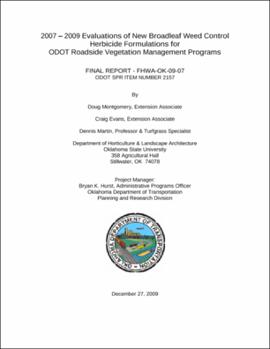| dc.creator | Montgomery, Doug | |
| dc.creator | Evans, Craig | |
| dc.creator | Martin, Dennis | |
| dc.date.accessioned | 2018-04-20T22:47:18Z | |
| dc.date.available | 2018-04-20T22:47:18Z | |
| dc.date.issued | 2009-12 | |
| dc.identifier.govdoc | FHWA-OK-09-07 | |
| dc.identifier.other | Oklahoma Department of Transportation State Planning and Research item number 2157 | |
| dc.identifier.uri | https://hdl.handle.net/11244/299484 | |
| dc.description.abstract | A three year research project was conducted between the Oklahoma Department of Transportation (ODOT) and the Oklahoma State University to investigate herbicides and herbicide tank mixes that could supplement existing ODOT weed control programs in the safety zone. Two studies were conducted using generic herbicides MSM E-Pro (metsulfuron methyl) and Diuron 80 WDG (diuron). Both provided similar control of broadleaf weeds as compared to the current equivalent industry standard formulations. Two studies were conducted to evaluate efficacy of Milestone VM (aminopyralid) and Milestone VM blended formulations. We do not believe the new blended Milestone VM formulations provide advantages in terms of efficacy, safety, or price over the current postemergence standard treatments used by ODOT. Five studies were conducted to evaluate BAS 80003 (saflufenacil), a new herbicide active ingredient manufactured by BASF. Saflufenacil was found to provide benefits to ODOT broadleaf weed control programs. This product produces quick broadleaf weed control activity in the first 2-3 days on susceptible species and may provide for a higher degree of safety around sensitive crops due to its low volatility. Nine studies were conducted to evaluate DPX-MAT28 (aminocyclopyrachlor) a new herbicide active ingredient manufactured by Dupont. This product has potential to provide significant benefits to ODOT broadleaf and grassy weed control programs. DPX-MAT28 produced good control of many annual broadleaf weeds. Most important, DPX-MAT28 has shown significant activity for both preemergence kochia (Kochia scoparia) control and postemergence Palmer amaranth (Amaranthus palmeri) control. Both of these weed species currently pose serious problems for ODOT. Specific weed control results from this product are very dependent on both timing and rate of application. Additional work with aminocyclopyrachlor will need to continue in the future to finalize product rate, application timings, and weed control spectrum. Provided that Federal as well as Oklahoma State labeling of several products occurs in combination with a competitive bid process, several new, cost effective and efficacious products will be available to ODOT for weed control purposes in the future. | |
| dc.format.extent | 62 pages | |
| dc.format.extent | 1,647,504 bytes | |
| dc.format.medium | application.pdf | |
| dc.language | en_US | |
| dc.relation.ispartofseries | No | |
| dc.relation.requires | Adobe Acrobat Reader | |
| dc.relation.uri | http://www.okladot.state.ok.us/hqdiv/p-r-div/spr-rip/library/2156-2157/2009final.pdf | |
| dc.title | 2007 – 2009 Evaluations of New Broadleaf Weed Control Herbicide Formulations for ODOT Roadside Vegetation Management Programs (FHWA-OK-09-07 2157) | |
| dc.type | Technical Report | |
| dc.description.version | Final report, October 2006-September 2009 | |
| dc.description.peerreview | No | |
| dc.type.material | text | |
| dc.subject.keywords | Broadleaf weeds | |
| dc.subject.keywords | herbicides | |
| dc.subject.keywords | weed control | |
| dc.subject.keywords | right-of-way | |
| dc.subject.keywords | bermudagrass | |
| dc.contributor.sponsor | Oklahoma Department of Transportation. Materials and Research Division. Office of Research & Implementation | |
